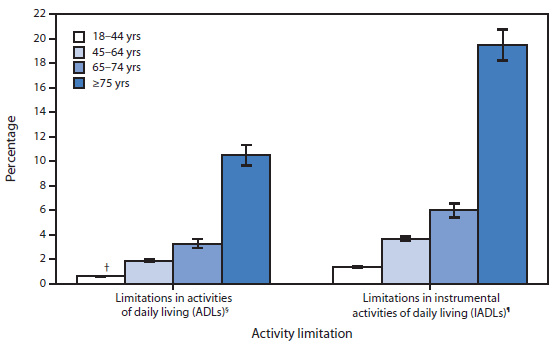QuickStats: Percentage of Adults with Activity Limitations, by Age Group and Type of Limitation — National Health Interview Survey,* United States, 2012

* Estimates are based on household interviews of a sample of the civilian noninstitutionalized U.S. population. Persons with unknown limitation status were excluded from the denominators.
† 95% confidence interval.
§ Limitations in ADLs are based on response to the question, "Because of a physical, mental, or emotional problem, does [person] need the help of other persons with personal care needs, such as eating, bathing, dressing, or getting around inside this home?" Respondents were asked to answer regarding themselves and other family members living in the same household.
¶ Limitations in IADLs are based on response to the question, "Because of a physical, mental, or emotional problem, does [person] need the help of other persons in handling routine needs, such as everyday household chores, doing necessary business, shopping, or getting around for other purposes?" Respondents were asked to answer regarding themselves and other family members living in the same household.
In 2012, the percentages of adults with limitations in activities of daily living (ADLs) and limitations in instrumental activities of daily living (IADLs) increased with age. Adults aged ≥75 years were the most likely to require the help of another person with ADLs and with IADLs.
Source: Adams PF, Kirzinger WK, Martinez ME. Summary health statistics for the U.S. population: National Health Interview Survey, 2012. Vital Health Stat 2013;10(259). Available at http://www.cdc.gov/nchs/data/series/sr_10/sr10_259.pdf.
Reported by: Patricia F. Adams, pfa1@cdc.gov, 301-458-4063; Michael E. Martinez, MPH, MHSA; Whitney K. Kirzinger, MPH.
Alternate Text: The figure above shows the percentage of adults with activity limitations, by age group and type of limitation in the United States during 2012. In 2012, the percentages of adults with limitations in activities of daily living (ADLs) and limitations in instrumental activities of daily living (IADLs) increased with age. Adults aged ≥75 years were the most likely to require the help of another person with ADLs and with IADLs.
Use of trade names and commercial sources is for identification only and does not imply endorsement by the U.S. Department of
Health and Human Services.
References to non-CDC sites on the Internet are
provided as a service to MMWR readers and do not constitute or imply
endorsement of these organizations or their programs by CDC or the U.S.
Department of Health and Human Services. CDC is not responsible for the content
of pages found at these sites. URL addresses listed in MMWR were current as of
the date of publication.
All MMWR HTML versions of articles are electronic conversions from typeset documents.
This conversion might result in character translation or format errors in the HTML version.
Users are referred to the electronic PDF version (http://www.cdc.gov/mmwr)
and/or the original MMWR paper copy for printable versions of official text, figures, and tables.
An original paper copy of this issue can be obtained from the Superintendent of Documents, U.S.
Government Printing Office (GPO), Washington, DC 20402-9371;
telephone: (202) 512-1800. Contact GPO for current prices.
**Questions or messages regarding errors in formatting should be addressed to
mmwrq@cdc.gov.
 ShareCompartir
ShareCompartir


